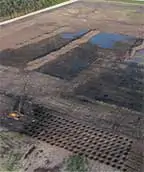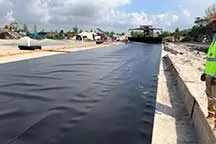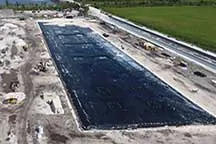

See SCS Engineers Stormwater Management Services
As large tracts of geographically desirable vacant land become scarcer, residential and commercial property developers are increasingly turning to old landfills or former dumps. However, such redevelopment is complex and rife with uncertainties. When compared to greenfield development, the land acquisition costs are lower. Still, any savings are typically offset by greater environmental and infrastructure costs associated with the foundation, landfill gas management, stormwater management, groundwater impacts, meeting closure requirements, and multiple regulatory agency coordination. Therefore, it is important to maximize the developable area while providing engineering solutions to make the project economically feasible. In this blog, we identify some options to reuse challenging sites and lessons learned to contribute to successful redevelopment projects.

Deep Dynamic Compaction
Old landfills or dumps present some unique soil stability challenges. Deep dynamic compaction (DDC) is a ground stabilization technique that has gained popularity in recent years to improve subsurface soil conditions. DDC involves dropping 6 to 30-ton weights from a height between 30 and 75 feet to achieve the desired soil compaction. DDC can effectively apply to a range of subsurface materials, including former C&D debris or municipal solid waste dumps.
DDC provides a stable foundation for future development, minimizes differential settlement while leaving the landfill waste in place, and eliminates the costs associated with removing, transporting, and disposing of buried waste, costing millions of dollars. For simplicity’s sake, let’s consider a 1-acre old landfill or a dumpsite with an average of 15 feet of waste. If excavating the waste and replacing it with clean fill, the disposal fee costs for the excavated waste alone could exceed $400,000. Alternatively, DDC costs range from $1.50 to $2.00 per square foot or $65,000 to $87,120 per acre, excluding mobilization, which costs around $30,000.

Gas Mitigation Systems
Constructing buildings on top of dynamically compacted areas generally requires a combustible gas barrier layer below the building foundation to manage subsurface combustible gases (typically methane). The barrier is required because the waste remains in place. In its simplified form, gas mitigation systems include:

These gas mitigation systems can be either a passive or an active system with a blower. The cost of such systems varies depending on the size of the building, location, and type of liner system used. Typical capital costs for passive systems are in the range of $7 to $9 per square foot for the spray-applied liner and $3 to $4 per square foot for the HDPE liner. For an active system using blowers, add $3 to $4 per square foot. The designer configures a system from these options to address the client’s risk preference and considering future tenant preferences.
Using innovative approaches, impaired lands are increasingly attractive to developers. Beyond the cost-saving benefits to developers realized through DDC and an appropriate gas mitigation system, such projects also create local jobs, increase the tax base, and protect public health and the environment.
About the Authors:

Stormwater management at landfills is changing as owners/operators are adapting their operating plans and designs to minimize the risks that come with heavier rainfall, and severe storm conditions. Landfill engineers are “overdesigning,” in regions hard hit in recent years by severe weather, and not designing for what is labeled as a statistically probable 25-year-storm.
Operations and maintenance are also preparing for changing conditions. William Mojica, Republic Services Director of Environmental Compliance is quoted in this article saying “It’s understanding the facility’s lifecycle, what best management practices (BMPs) are required and anticipating what may come.”
Jonathan Meronek, of SCS Engineers, notes similar strategies are being explored or employed along the U.S. coastlines including designing retention facilities to handle much larger storms.
By October 17, 2016, coal combustion residual (CCR) landfills subject to the Environmental Protection Agency’s (EPA) CCR regulations published at 40 CFR 257, Subpart D, also known as the Federal CCR Rule, were required to prepare a Run-on and Run-off Control System Plan. Your plan documents how you have designed and constructed your landfill to prevent storm water from running onto or off the active landfill. But, what’s next?
Have you addressed run-on and run-off control system operation and maintenance?
Spring is a great time to review your storm water control plans and, more importantly, your storm water controls. The snow is gone now and spring rains are on their way, so knowing that your storm water controls are working and water is going where you intend it to go should be part of your spring inspection routine. Don’t want to waste money managing clean storm water with your leachate management system, or put your facility at risk by allowing unintended runoff from the landfill. A few basic inspection tasks will help ensure you don’t.
A spring run-on and run-off control system inspection should include the following:
Don’t let spring rains catch you off guard. SCS Engineers can help you assess the effectiveness of your run-on and run-off control systems. For help conducting storm water inspections as well as studies to review leachate, contact water, and storm water minimization and reuse opportunities, or for questions about run-on and run-off control system inspections or more information about minimization and reuse studies, please contact:
Mike McLaughlin, PE, Senior Vice President
Eric Nelson, PE, Vice President
Steve Lamb, PE, Vice President
Kevin Yard, PE, Vice President
Or, contact your local SCS Engineers office.
Learn more about the author Eric Nelson:
Eric J. Nelson, PE, is a Vice President of SCS Engineers and our National Expert for Coal Combustion Residuals (CCR). He is an experienced engineer and hydrogeologist. His diverse experience includes solid waste landfill development, soil and groundwater remediation, and brownfield redevelopment.
Mr. Nelson has worked with utility clients to complete numerous projects for dry CCR landfills, CCR ponds, and general environmental monitoring and compliance. He has been involved with CCR landfill projects that include feasibility analyses and permitting of landfill expansions; hydrogeologic and geotechnical site investigations; site design and operating plans; soil borrow source identification and permitting; liner and final cover construction liner, cover, and storm water management repairs. He has worked with utility clients to evaluate, plan, permit and complete CCR pond repairs and closures.
Mr. Nelsons environmental monitoring and compliance experience includes groundwater monitoring; oil containment design and construction; and Spill Prevention, Control, and Countermeasure (SPCC) planning. This diverse project experience has provided him the opportunity to work on challenging and innovative projects that have included design and permitting for wetland and stream mitigation, identifying and avoiding former underground mines during site design, and assessing the feasibility of installing a solar photovoltaic system on a closed CCR landfill.
Mr. Nelsons additional areas of expertise include remedial action planning, cost estimating, bidding and construction documents, and construction quality assurance. He has worked with electric utilities, solid waste facility owners/operators, and private property owners and developers.

Jim Bowlby of SCS-Denver was just selected by a committee of his peers to be the featured member on the HBA’s website. Each week the HBA puts a “Spotlight On” an individual to introduce and acknowledge their accomplishments and contributions in support of home building within the industry.
What accomplishment or contribution to the Home Building industry are you most proud? “My active participation in the Stormwater Committee for the past 12-13 years, now as chair for the last three years,” replied Jim. “We’ve disseminated information, commented on pending regulations, met with most of the Denver Metro Front Range Municipal stormwater managers and the State Health Department, and provided an avenue for exchanging information and ideas.”
To learn more about Stormwater Management click here.
For the full article go to the HBA website or click here.